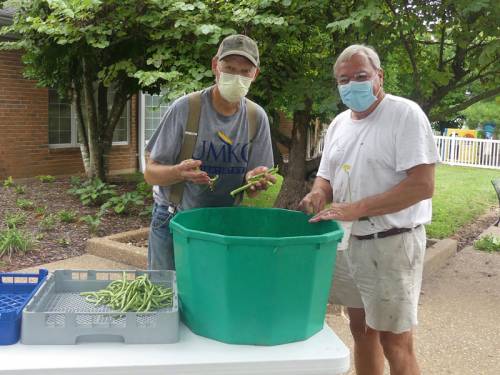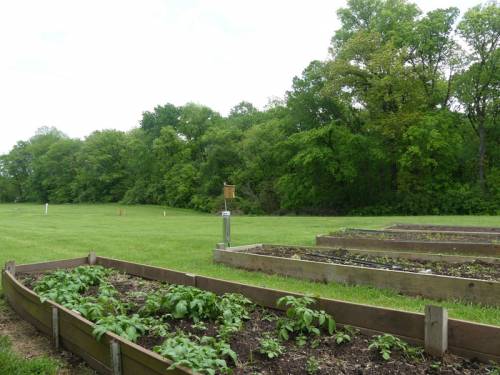Wings of joy delight community
By Aneeta Brown | Presbyterians Today

The Eastern Bluebird population was once declining, but with a little help from others — such as the congregation at the Presbyterian Church of Washington, Missouri — they are now thriving. These birds have found a place to call home in the church’s garden. Aneeta Brown
The Presbyterian Church of Washington, Missouri, likes bugs — outdoors, that is. So much so that Jolene Patterson, described by many in the congregation as the “capable and creative” chairman of the mission committee, recently wrote and obtained three grants to fund an expansion of the church’s mission garden. The garden was started about six years ago by longtime member David Brunworth, a recently retired family physician. As all gardeners know, larger gardens attract more insects — and more insects mean more birds. That’s the short story of how the Eastern Bluebird discovered one lone nesting box in the church’s backyard.
The bluebirds were in no hurry to visit the church. Founded in 1850, the downtown congregation moved to its current location at the edge of town in 1993. The property, which once produced corn and wheat, comprises 11 acres. Its neatly mowed backyard is spacious enough to contain at least two regulation-size football fields. Dozens of hardwood and pine trees make a picturesque landscape. Yet, except for an occasional worship service on the church’s patio and a few Vacation Bible School activities, the well-maintained property was largely ignored.
Brunworth’s vision of a mission garden took root with a few small plots stationed near the patio. Soon, a few yards away from those small plots, four raised beds, each 40 feet by 3 feet, were added. Assisting Brunworth with planting, weeding, watering and maintenance was Steven Sebastian, a new church member who retired after a long career as a golf pro. The garden proved bountiful. By fall’s harvest, church members had gathered approximately 700 pounds of Yukon Gold potatoes, sweet potatoes, tomatoes, green beans, spinach and lettuce as well as 500 banana peppers and 50 bell peppers. Every ounce of it was donated, most of it to the town’s food pantry.
Amid all the planting, weeding and harvesting, Brunworth and Sebastian were looking to add another mission project to the garden: that of attracting and providing a refuge for the Eastern Bluebird, a species once as common as the robin. The men placed a simple bluebird box near the edge of the garden. To their delight, and the delight of those who worked the garden beds, the blue-feathered birds with their rosy breasts came, feasting on a buffet of insects.
Presbyterian Church of Washington, Missouri, member, Kathy Rogers, appreciated the addition of the bluebird box near the garden. “I had one at my house, but the bluebirds wouldn’t come. The houses in our neighborhood must be too close together,” she said, noting how bluebirds need their boxes to be distanced from one another. In addition to being treated to seeing the birds flutter about, Rogers has enjoyed getting her hands dirty and working in the garden. “It is a good way to get better acquainted with members I don’t know,” she said.
The enchanted bluebird
Many people like Rogers are enchanted with the bluebird. In 1859, Henry David Thoreau wrote a poem about bluebirds, poetically penning how “the bluebird carries the sky on his back.” Decades later, Judy Garland sang about a bluebird in the 1939 film “The Wizard of Oz,” capturing the symbolism of joy the bird is noted for: “Somewhere over the rainbow, bluebirds fly.” According to the Smithsonian’s National Postal Museum, the bestselling stamps in U.S. history — up to 1982 — were the state birds and flowers stamps issued that year; among them was the Eastern Bluebird, which is the state bird of Missouri and New York. There is also the Mountain Bluebird, the state bird of Idaho and Nevada.
The bluebird didn’t escape the notice of acclaimed 19th-century artist and ornithologist John James Audubon. “This lovely bird,” he wrote in his field notes, “adds to the delight imported by spring … enlivens the dull days of winter … forms its nest in the box made expressly for the purpose, or in any convenient hole or cavity it can find.”
If Audubon wrote about bluebirds and nesting boxes 200 years ago, and music, film and poetry have highlighted the beauty of the species, why have so many Americans never seen an Eastern Bluebird?
Elizabeth “Bet” Zimmerman, a board member of the North American Bluebird Society, who writes extensively about bluebird history on her website Sialis (the scientific name for the Eastern Bluebird is Sialia sialis), explains: “When the first settlers arrived from England, bluebirds were probably as common as the American robin. But bluebirds suffered a major decline from the 1920s to the 1970s. The bluebird population depends in part on the weather, predators and the availability of food. It is also directly affected by the availability of, and competition for, nest sites.”
During that 50-year decline, Zimmerman explained the insecticide DDT was used, which severely reduced the insect population. Insects are two-thirds of a bluebird’s diet. In addition to the reduced insect population, the winter of 1977–78 was the coldest on record for the previous 110 years, and some states estimated a 60% loss of bluebirds. “Cold and wet weather during breeding season, ice and even hurricanes can decimate regional bluebird populations,” said Zimmerman, adding, too, that a continuing threat is the House Sparrow, which was introduced into the U.S. from England in 1852 and now numbers 150 million. “House Sparrows will aggressively compete for nesting sites and destroy bluebird eggs,” she said.
Providing homes for the birds
The beaks and feet of Eastern Bluebirds are not strong enough to dig out nesting homes, so they reuse cavities created by bigger birds. According to Zimmerman, human-made nesting boxes provide better protection from the weather and predators than trees do. A proper-sized entrance hole keeps out starlings, and the absence of a perch detracts sparrows. Nesting box blueprints and material recommendations are available for free on many websites. (See the “Do More” section below.)

David Brunworth, left, a member of the Presbyterian Church of Washington, Missouri, had a vision for a mission garden. In addition to growing vegatables, that garden now provides the Eastern Bluebird a home. Pictured with Brunworth is church member, Steven Sebastian. Aneeta Brown
As they worked in the mission garden, Brunworth and Sebastian were confident that the church backyard would be a good habitat for bluebirds. Actually, it was the ideal habitat. Bluebirds like open spaces near trees as well as meadows, orchards, gardens and pastures. And so, a bluebird box was erected. Everyone kept an eye on the box hoping for feathered tenants to move in. Finally, the bluebirds arrived at the church in late April 2020.
“It was exciting and encouraging,” said Brunworth’s wife, Diane. She was working in the church garden when she noticed bluebirds flitting around the nesting box. They were building a home. Three eggs were laid and hatched. At least six adult bluebirds collected food for the healthy trio. Another member of the church documented the bluebird activity by taking photos over a 15-day period. And much to the bluebirds’ surrogate church family’s relief, no predators — cats, raccoons or snakes — harmed the nestlings.
Brunworth knows something about predators. “A few years ago, I was out golfing and noticed a bluebird box in the distance,” he said. “As I walked closer, I saw that the post holding the nesting box wasn’t protected with anything. Wrapped up on top of the box was a black snake about 6 feet long. So, I took my 8-iron, carefully lifted him off, and flung him into the nearby woods.”
A mission and a hobby
The American Bird Conservancy describes Eastern Bluebirds as “partial migrants.” They will move south or stay near their nesting grounds depending on the weather and food availability. They can be found, at various times, in more than half of the land area of the U.S., as far north as the Canadian border and as far west as eastern Colorado.

The Rev. Patrick Gruber has rearranged his office furniture to get a better view of the church’s garden — and the many bluebirds flying around. This year, there will be more bluebirds to watch as church members have added more bluebird boxes. Aneeta Brown
Installing nesting boxes and then monitoring the contents has become a mission for the congregation of Presbyterian Church of Washington, Missouri. And they are not alone. Caring for the birds is growing in popularity. Take, for instance, Lynn Buchanan, who helps out at the Shaw Nature Reserve in Gray Summit, Missouri, just 10 miles from the church. Owned by the Missouri Botanical Garden in St. Louis, Shaw’s 2,400 acres have welcomed the Eastern Bluebird for decades and now has 85 boxes.
“My two volunteers and I monitor, repair, replace and clean the boxes April through August because bluebirds can have three broods a year,” said Buchanan. “Once a week, we open each box and use a mirror to look inside. If the mother bird is nesting, she often won’t move while we’re working. I’ve been doing this for 14 years, and our boxes typically fledge between 300 and 350 bluebirds every year.” Fledglings are baby birds ready to leave the nest.
About 20 million Eastern Bluebirds now live in the U.S., and state bluebird societies have become powerful advocates for them. In 2019, the Missouri Bluebird Society reported that 2,184 bluebirds had fledged, a 97% increase from 2009.
The Presbyterian Church of Washington’s ministry to welcome the Eastern Bluebird to its property could not have come at a better time.
In folklore and Native American symbolism, the bluebird is often associated with the return of joy and happiness coming back into one’s life. For the church’s COVID-19-weary congregation, seeing the Eastern Bluebirds beginning to flutter amid the boxes this past winter was a healing balm for church members.
And this year, there will be more bluebirds on the property as three boxes, not just one, are now in the mission garden, all 100 yards apart from one another. Every church member knows that God created the dazzling Eastern Bluebird.
The church’s hospitality to that bird is simply a sign of deep gratitude. The Rev. Patrick Gruber, pastor of Presbyterian Church of Washington, Missouri — eager to take in all of this gratitude — has even rearranged his office furniture to get a better view of the feathered action outside.
Aneeta Brown is an elder in the Presbyterian Church of Washington, Missouri, and the newsletter editor for the Franklin County Humane Society in Union, Missouri.
Do more
Is your property spacious enough for a bluebird ministry? To learn more about attracting and caring for bluebirds, visit the North American Bluebird Society at nabluebirdsociety.org or go to the Cornell Lab of Ornithology at birds.cornell.edu. If bluebirds are not in your region, what other birds or wildlife can your congregation adopt?
Support Presbyterian Today’s publishing ministry. Click to give
![]() You may freely reuse and distribute this article in its entirety for non-commercial purposes in any medium. Please include author attribution, photography credits, and a link to the original article. This work is licensed under a Creative Commons Attribution-NonCommercial-NoDeratives 4.0 International License.
You may freely reuse and distribute this article in its entirety for non-commercial purposes in any medium. Please include author attribution, photography credits, and a link to the original article. This work is licensed under a Creative Commons Attribution-NonCommercial-NoDeratives 4.0 International License.
Categories: Presbyterians Today
Tags: birds, Bluebirds, church garden, garden
Ministries: Presbyterians Today